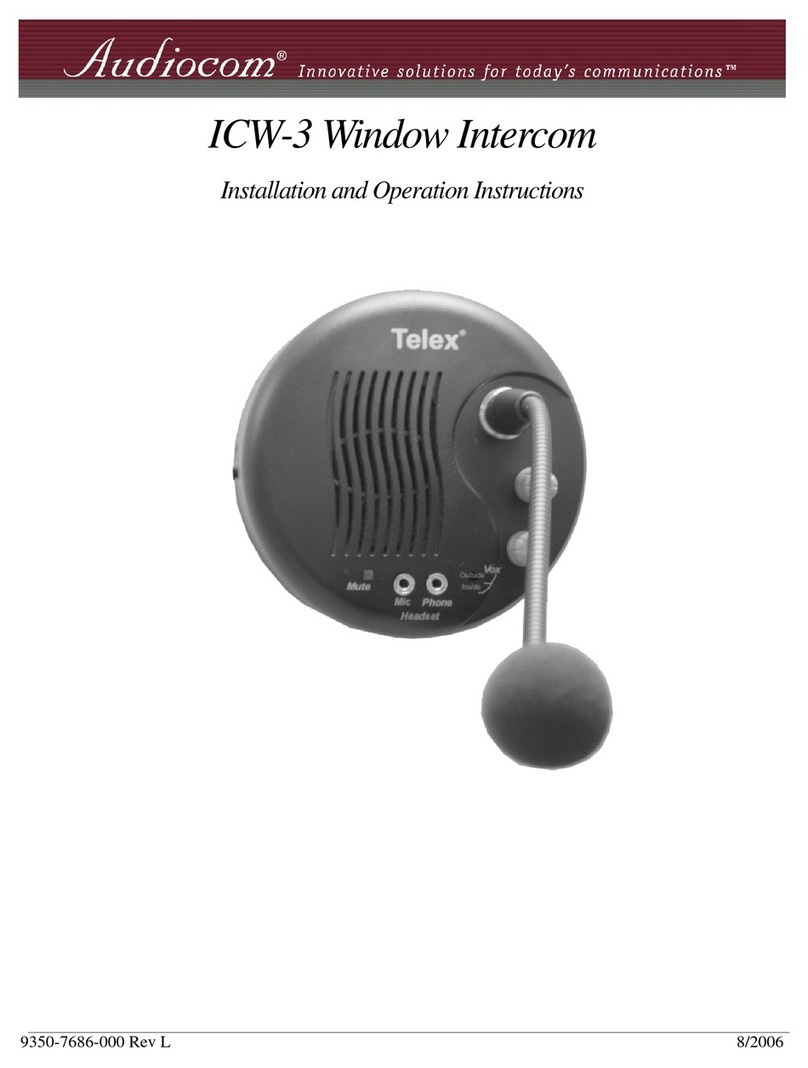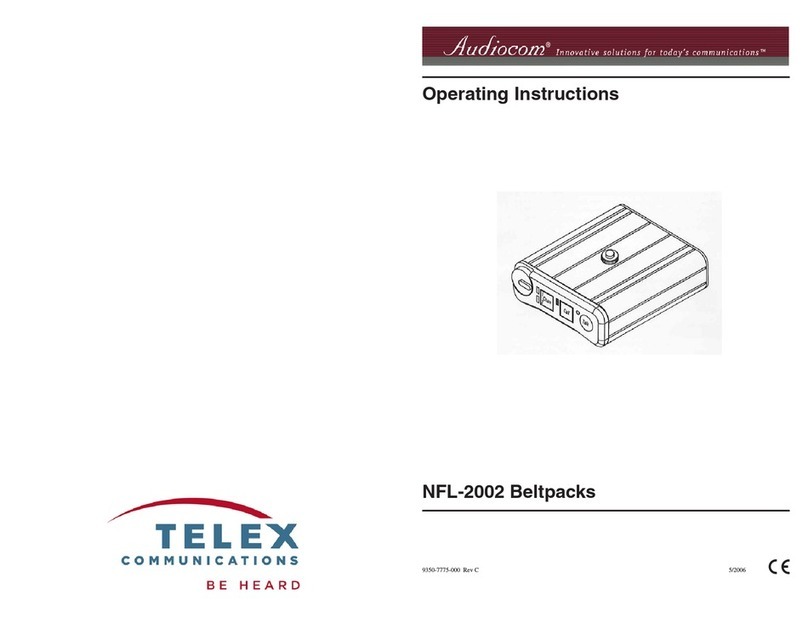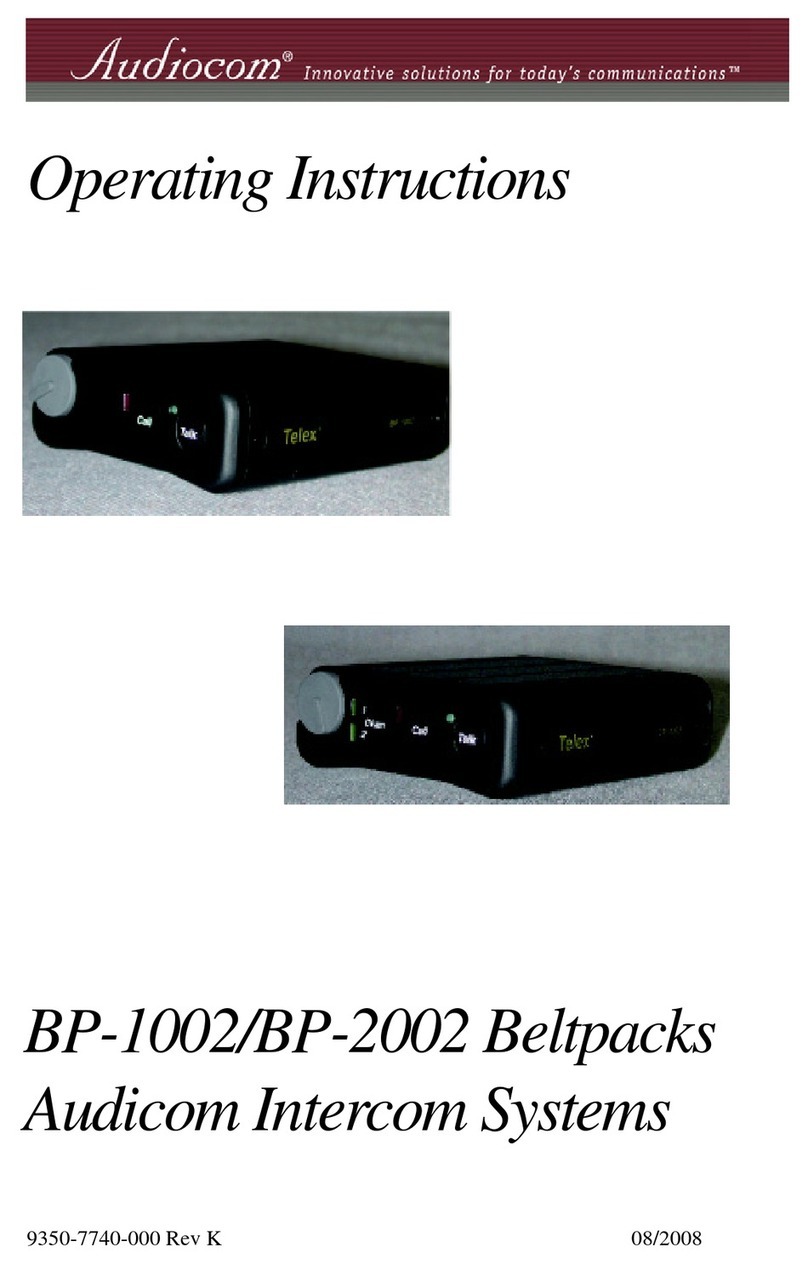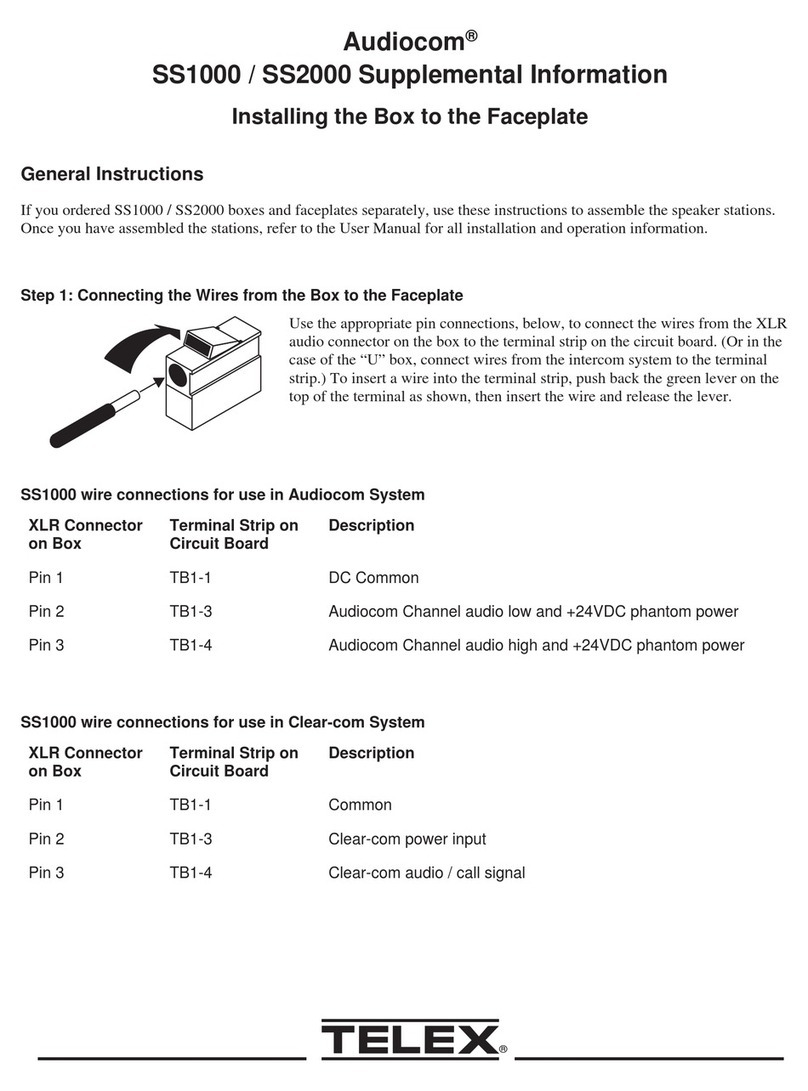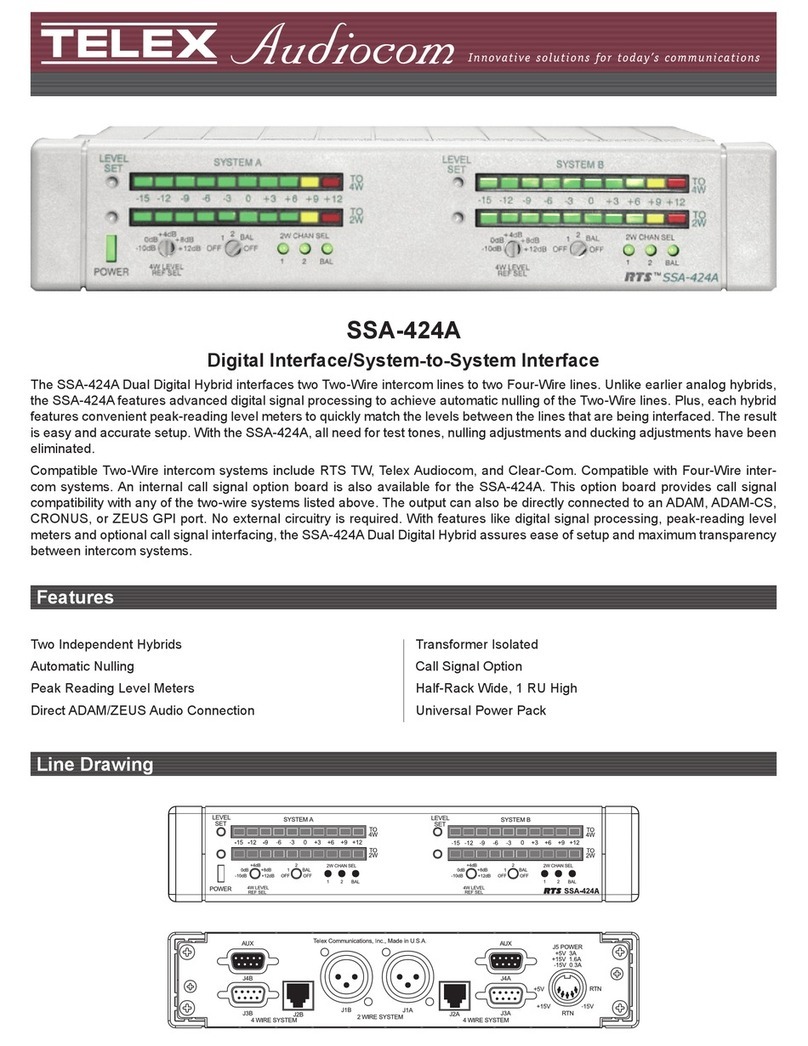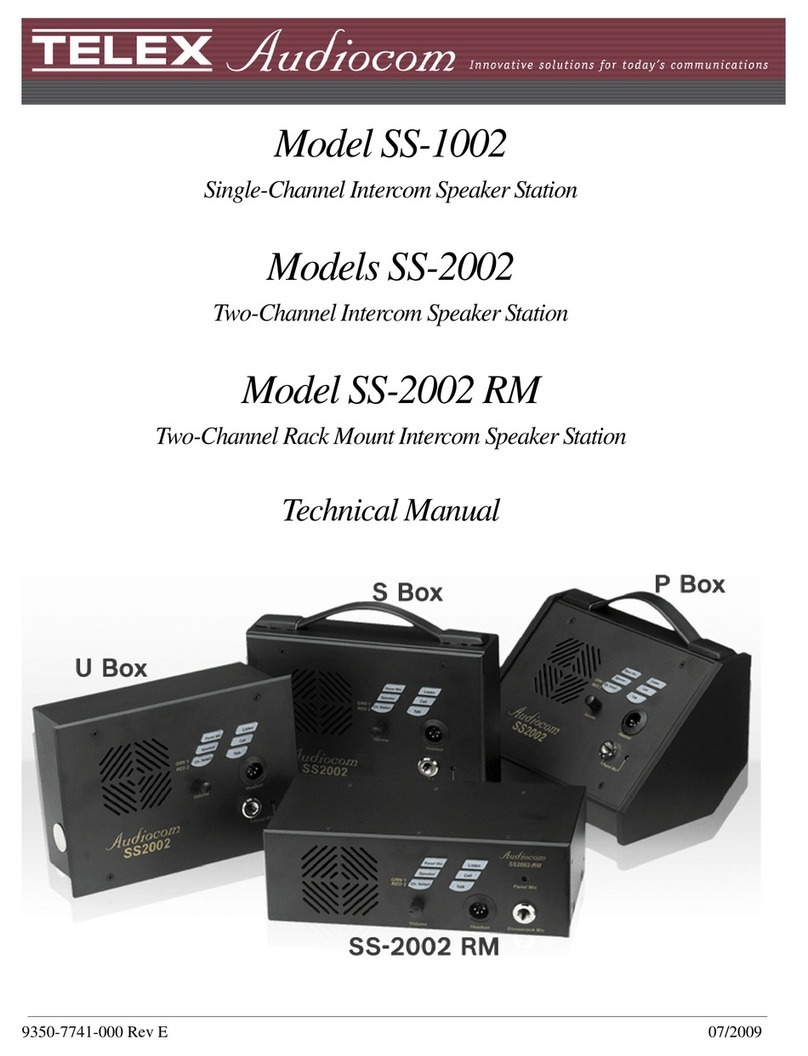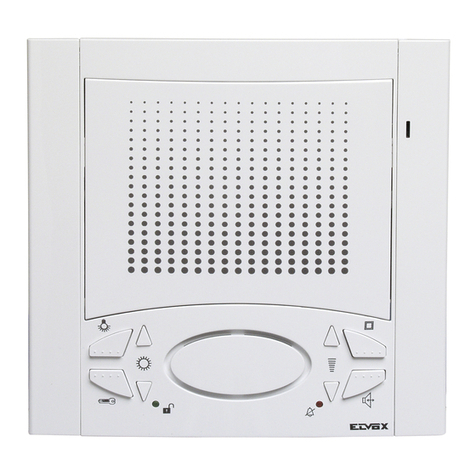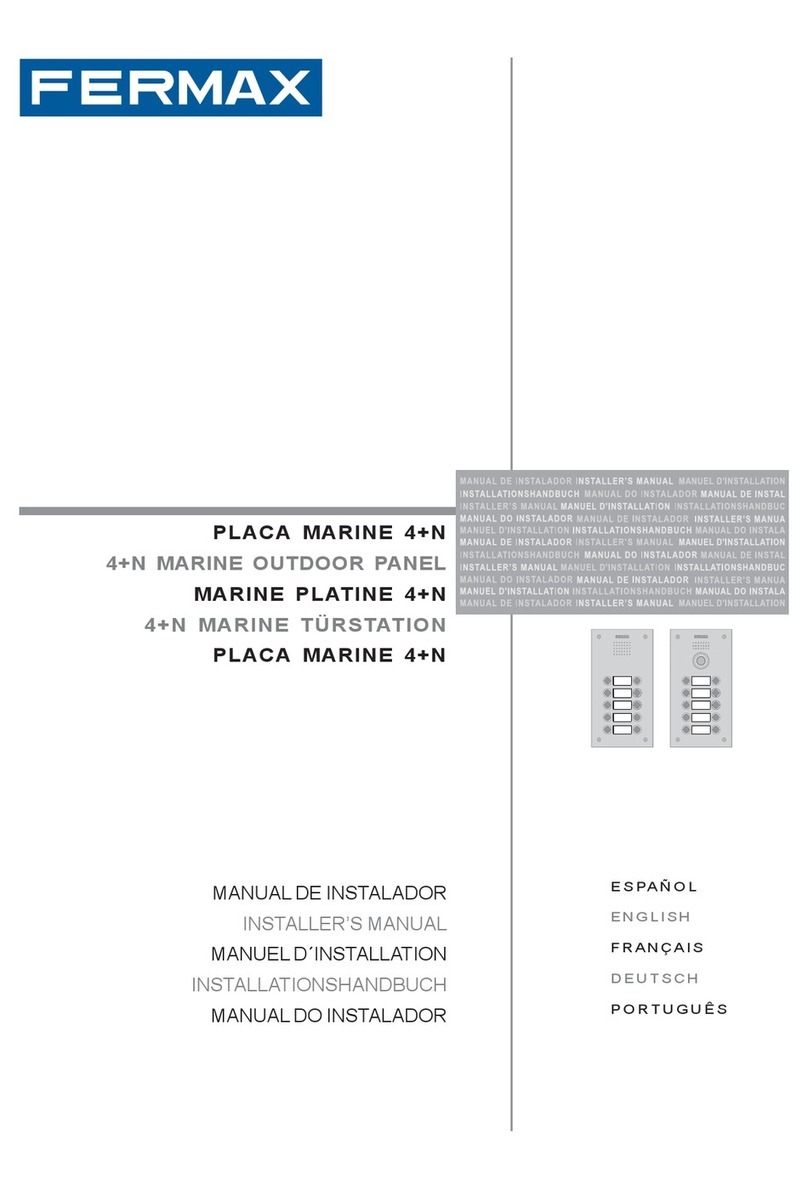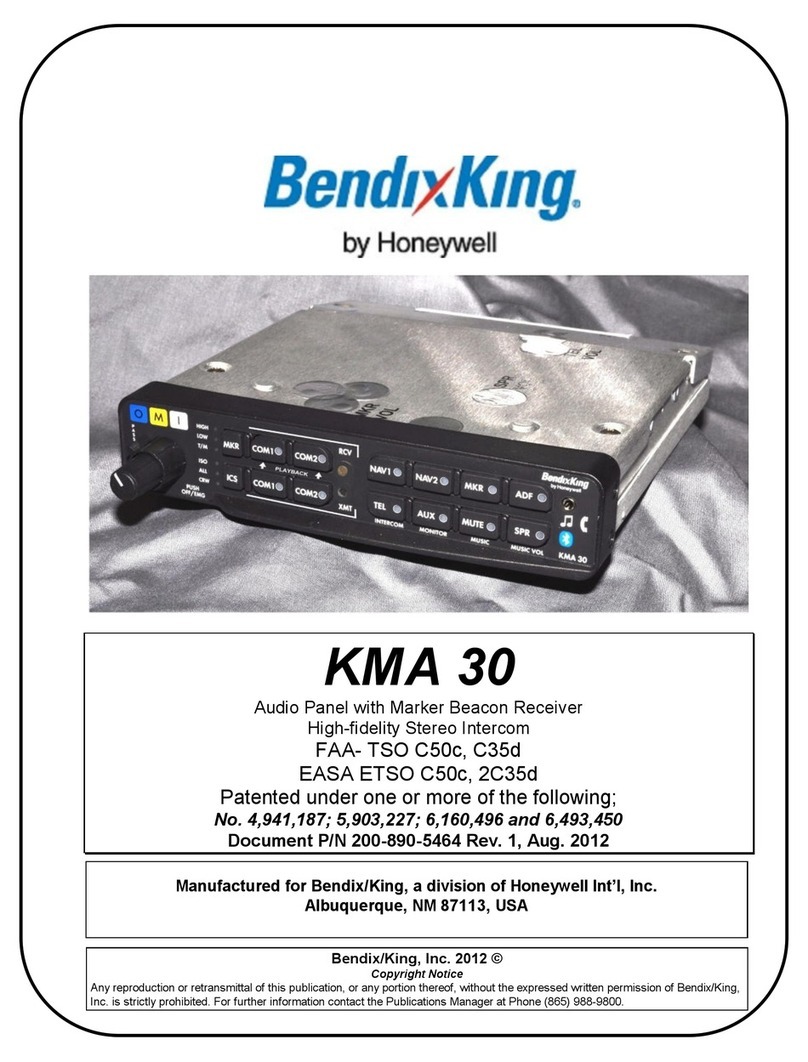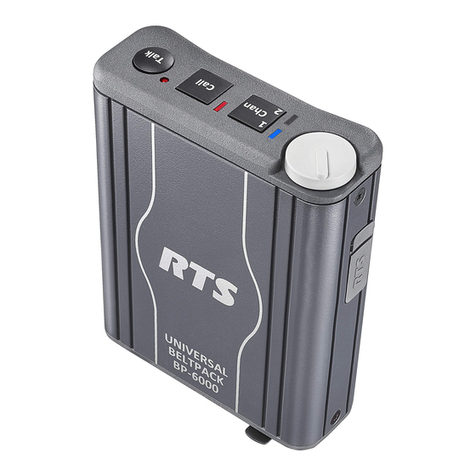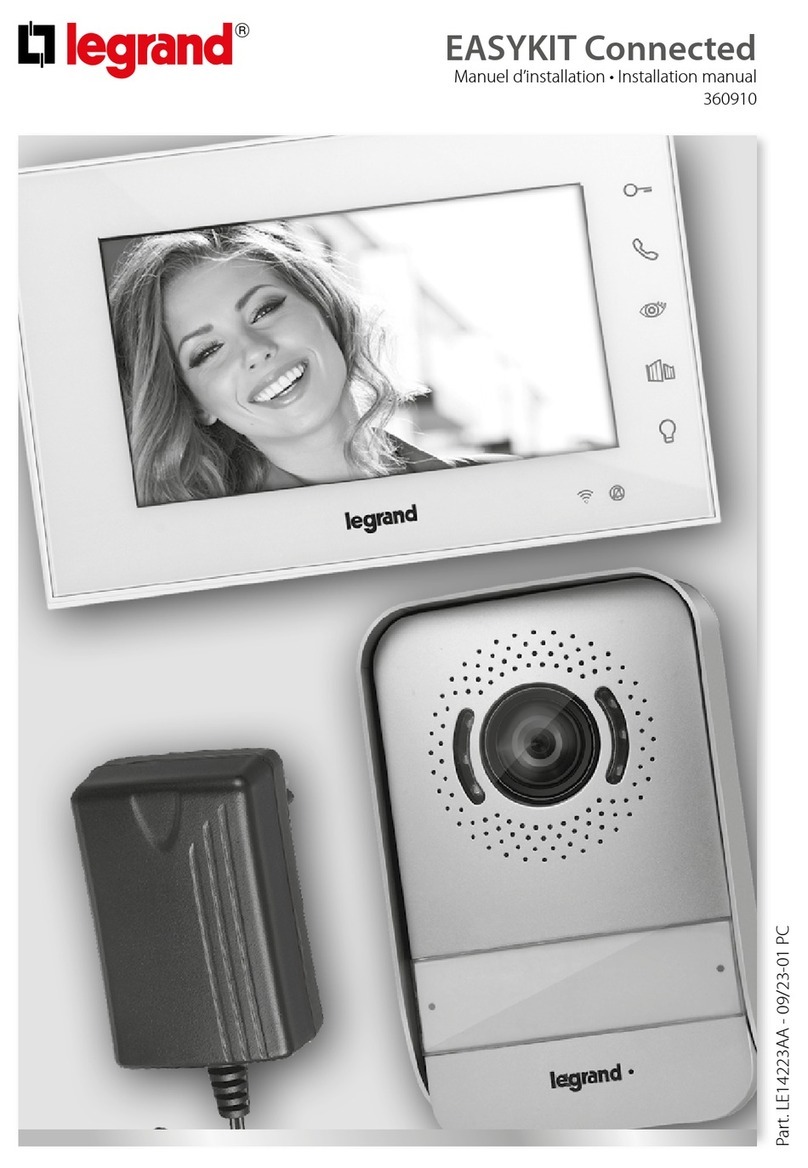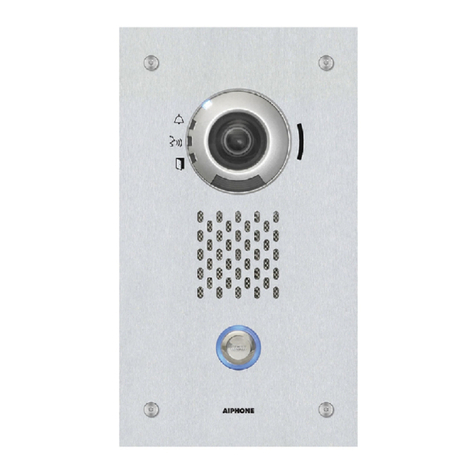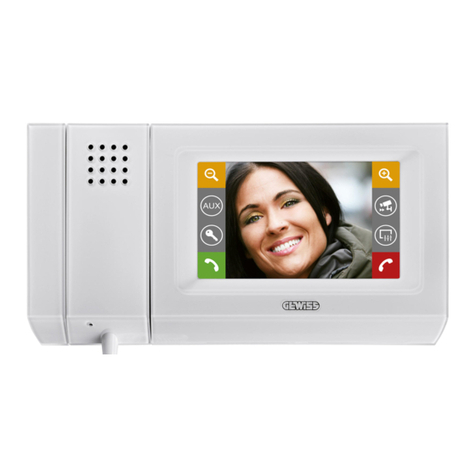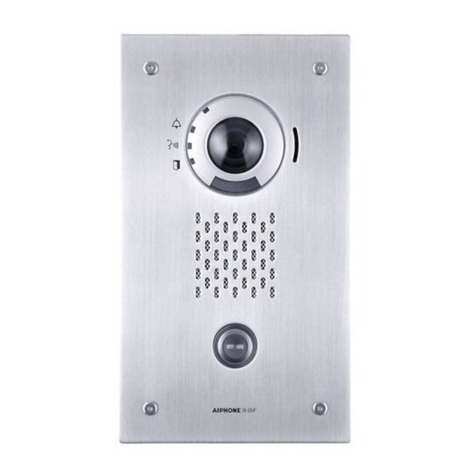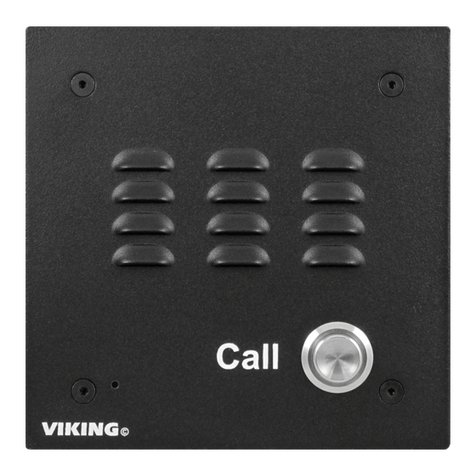Audiocom SS-1002 User manual

Model SS-1002
Single Channel
Intercom Speaker
Station
Models SS-2002
Two Channel
Intercom Speaker
Station
Model SS-2002 RM
Two Channel Rack
Mount Intercom
Speaker
Station
9350-7741-000 Rev B 05/2006

PROPRIETARY NOTICE
The product information and design disclosed herein were originated by
and are the property of Telex Communications, Inc. Telex reserves all
patent, proprietary design, manufacturing, reproduction, use and sales
rights thereto, and to any article disclosed therein, except to the extent
rights are expressly granted to others.
COPYRIGHT NOTICE
Copyright 2006 by Telex Communications, Inc. All rights reserved.
Reproduction, in whole or in part, without prior written permission from
Telex is prohibited.
WARRANTY NOTICE
See the enclosed warranty card for further details.
CUSTOMER SUPPORT
Technical questions should be directed to:
Customer Service Department
RTS/Telex Communications, Inc.
12000 Portland Avenue South
Burnsville, MN 55337 USA
Telephone: 800-392-3497
Fax: 800-323-0498
Factory Service: 800-553-5992
RETURN SHIPPING INSTRUCTIONS
Customer Service Department
Telex Communications, Inc. (Lincoln, NE)
Telephone: 402-467-5321
Fax: 402-467-3279
Factory Service: 800-553-5992
Please include a note in the box which supplies the company name,
address, phone number, a person to contact regarding the repair, the type
and quantity of equipment, a description of the problem and the serial
number(s).
FCC Statement
This equipment uses, and can radiate radio frequency energy that
may cause interference to radio communications if not installed
in accordance with this manual. The equipment has been tested
found to comply with the limits of a Class A computing device
pursuant to Subpart J Part 15 of FCC Rules which are designed to
provide reasonable protection against such interference when
operated in a commercial environment. Operation of this
equipment in a residential area may cause interference which the
user (at his own expense) will be required to correct.
This product meets Electromagnetic Compatibility
Directive 89/336/EEC
Shipping to the Manufacturer
All shipments of product should be made via UPS Ground, prepaid (you
may request from Factory Service a different shipment method). Any
shipment upgrades will be paid by the customer. The equipment should
be shipped in the original packing carton. If the original carton is not
available, use any suitable container that is rigid and of adequate size. If
a substitute container is used, the equipment should be wrapped in paper
and surrounded with at least four (4) inches of excelsior or similar
shock-absorbing material. All shipments must be sent to the following
address and must include the Proof of Purchase for warranty repair.
Upon completion of any repair the equipment will be returned via
United Parcel Service or specified shipper, collect.
Factory Service Department
Telex Communications, Inc.
8601 East Cornhusker Hwy.
Lincoln, NE 68507 U.S.A.
Attn: Service
This package should include the following:
QTY DESCRIPTION PART NO.
1 SS-1002, 1 channel front plate
assembly
9010-7741-000
1 SS-2002, 2 channel front plate assem-
bly
9010-7741-001
1 User Manual 9350-7741-000
4 Screw, Flat Hd, 6-32 x 5/16” 51847-122
One of the following, depending on what was ordered:
1 P-box, 1-channel 9010-7627-007
1 S-box, w/handle, 1-channel 9010-7627-008
1 P-box, 2-channel 9010-7627-009
1 S-box, w/handle, 2-channel 9010-7627-010
1 U-box 9010-7627-004
1 S-box, w/out handle, 1-channel 9010-7627-011
1 S-box, w/out handle, 2-channel 9010-7627-012
1 Warranty Card 38110-390
2 End Caps 9310-7620-001
1 Statement of Conformity 38109-675
SS-2002RM
1 SS-2002RM Final Assembly 9010-7742-000
4 Foot, bumper, black 56471-001
1 User Instructions 9350-7741-000
1 Statement of Conformity 38109-675
1 Warranty 38110-390

TABL
E
OF
CONTENTS
Chapter 1 Introduction
Introduction ................................................................................................................................................. 3
Description .................................................................................................................................................. 3
Features ....................................................................................................................................................... 3
Chapter 2 Installation
Configuration Pre-check ............................................................................................................................. 7
DIP Switches ............................................................................................................................................... 7
Mic Kill Receive ......................................................................................................................................... 7
Call Signal Compatibility ........................................................................................................................... 8
Incoming Call Beep .................................................................................................................................... 8
Microphone Type ........................................................................................................................................ 8
Speaker Beep for Incoming Call ................................................................................................................. 8
Balanced / Unbalanced Switch ................................................................................................................... 8
Sidetone Trimmers ...................................................................................................................................... 9
Headset Connector Notes ............................................................................................................................ 9
Panel Mic Connector Notes ........................................................................................................................ 9
Intercom Channel Connections ................................................................................................................... 9
Description of Phantom-Powered Connection ......................................................................................... 10
Description of Locally Powered Connection ............................................................................................ 10
All Locally Powered Intercom Stations (Dry Lines) ................................................................................ 12
Chapter 3 Operation and Specifications
Power Up .................................................................................................................................................. 15
Sidetone Adjustment ................................................................................................................................. 15
Channel Select (SS-2002 & SS-2002RM Only) ....................................................................................... 16
Headset/Headphone/Speaker/Microphone Selection ................................................................................ 16
Receiving Calls ......................................................................................................................................... 16
Calling an Intercom Channel .................................................................................................................... 16
Specifications ............................................................................................................................................ 17
Dimensions ............................................................................................................................................... 18
Notes ......................................................................................................................................................... 19


3
CHAPTER 1
Introduction
Introduction
Thank you for purchasing the Audiocom SS-1002/2002/2002RM Intercom Speaker Station. We hope the many design features
of this product will satisfy your intercommunication requirements for many years to come. To get the most out of you new
intercom stations, please take a few moments to look through this booklet before using the Intercom Speaker Stations for the
first time.
Description
The Intercom Speaker Stations may be used with a headset, or with the built-in speaker and the panel microphone or an
optional gooseneck microphone. Another alternative is to use headphones and either the built-in panel microphone or an
optional gooseneck microphone. As an alternative to a headset, a telephone style handset may also be used. The SS-1002 is a
single-channel station; the SS-2002 & SS-2002RM provide switch selectable access to either of two intercom channels. Both
the SS-1002 and the SS-2002 com in three version to suit a variety of applications. The “S” box is a portable version. It has a
carrying handle and dual “loop-through” intercom connectors which permit stations to be quickly interconnected using pre-
fabricated cables. The “P” box is stationary version. It also has dual “loop-through” connectors for quick interconnection, but
the case is designed for desktop or console-mount applications. The “U” box is designed for permanent, in-the-wall mounting.
It uses push type wire terminals for connection to the intercom system. In addition, the SS-2002RM can be used on a desktop
or mounted in a standard 19” equipment rack (using the optional RM-14 Rack Mount Kit).
Features
1. Channel and Power Connections - The “U” box uses quick release terminals to connect to audio and power wires. For the
“S” box and “P” box versions, the terminal connections are brought out to the dual, loop-thru XLR connectors on the side
of the box. These permit several stations to be connected in a string, or daisy-chain, using pre-fabricated intercom cables.
2. Configuration DIP Switches - These switches control the following features:
Call Beep: In addition to a flashing call key indication for incoming calls, an incoming call beep tone can also be
used.
Headset Microphone Type Selection: Either a balanced or unbalanced dynamic microphone can be selected.
DC call enable: This may be turned on to use the intercom station with intercom systems that use DC call signaling.

Introduction
4
3. Panel Mic Key - Selects the Panel Mic connector / Built-in Mic (11) in the ON position and the headset connector (10) in
the OFF position.
4. Speaker Key - Selects the built-in speaker in the ON position and the Headset connector (10) in the OFF position.
5. Channel Select Key (SS-2002 & SS-2002RM only) - Selects intercom channel 1 or 2. The key lights green for channel 1 and
red for channel 2.
6. Volume Control - Adjusts intercom listen volume to headphones or speaker.
7. Intercom Listen Key - Both momentary (push-to-listen) and latching (hands-free-listen) are possible.
8. Call Key - Used to send call signals on the intercom channel. Flashes for incoming calls.
9. Intercom Talk Key - Both momentary (push-to-talk) and latching (hands-free-talk) are possible. All models are also
equipped with a “mic kill receive” circuit, which allows an operator at a remote master station (such as the US-2000A) to
turn OFF the talk key on all stations on the intercom line.
10. Dynamic-Mic Headset Connector - 4-pin male XLR connector accepts headsets with monaural headphones and either a
balanced or unbalanced dynamic microphone. Also accepts a telephone style handset. Can also be used with headphones
when a Panel Mic is connected. Can also be used with a handheld microphone along with the internal speaker.
11. Panel Mic Connector - Accepts an electret gooseneck microphone such as the Telex MCP-90.
12. Built-in Panel Microphone - Active when the Panel Mic key is pressed and a gooseneck microphone is not inserted in the
Panel Mic connector.
13. Sidetone Trimmers - These adjust the level of the user’s own voice in the headphones when using full-cushion headphones.
(Eliminates the muffled sensation when talking with the ears completely covered.) When using the speaker or open-ear
style headphones, the sidetone trimmers are adjusted to eliminate the user’s voice from the headphones or speaker. This
helps to prevent feedback.
14. Balanced / Unbalanced Selector Switch - This switch sets the intercom station for compatibility with either Audiocom
(balanced) or Clear-Com1(unbalanced) intercom systems.
FIGURE 1. SS-1002/2002 Features
1. Brand Names mentioned are the property of their respective companies.

5
Features
FIGURE 2. SS-2002RM Features

Introduction
6

7
CHAPTER 2
Installation
Configuration Pre-check
Before making connections, read the configuration notes that follow, and make sure that all internal controls are properly set
for your intended usage. If you need to access the internal controls, remove the four screws on the front that secure the
intercom station faceplate to the mounting box, then lift out the faceplate for all versions except the RM version. To access the
internal controls for the RM version, remove the 10 screws securing the cover on the box and then lift the cover.
DIP Switches
Table 1 lists DIP Switch descriptions and factory default settings.
Mic Kill Receive
Audiocom intercom stations, such as the US2002A can transmit an inaudible signals turn off the microphones in all remote
intercom stations on an intercom channel. This is useful when a remote intercom station has been left unattended with the
microphone ON. The procedure to send a mic kill signal from a master station is a two-step process, so it is very unlikely that
Switch
Number Description
Settings
Open = OFF; Closed = ON
Default
Settings
1 Mic Kill Receive Closed: Disabled, No Mic Kill
Open: Enabled, Mic Kill Active Open
2 Call Signal Method Closed: DC (SW1 set to UNBAL)
Open: Audiocom (SW1 set to BAL) Open
3 Incoming Call Beep Closed: Disabled
Open: Enabled Open
4 Microphone Type Closed: Unbalanced
Open: Balanced Open
5 Speaker Beep for Incoming Call Closed: Enabled (DIP switch 3 must be set to Open)
Open: Disabled Open
6 Not Used Not Defined Open
7 Not Used Not Defined Open
8 Not Used Not Defined Open

Installation
8
microphones will ever be turned OFF by accident. However, you may wish to disable the mic kill receive feature at the
intercom unit. You might do this, for example, if communications will be of a very critical nature where it is absolutely
essential the microphone never be remotely deactivated. To enable the mic kill receive function, set DIP switch 1 to the OPEN
position. To disable the mic kill function set DIP switch 1 to the closed position.
Call Signal Compatibility
For Audiocom setup, leave this switch in the open position, and also leave the Balanced / Unbalanced switch in the Balanced
position. For Clear-Com setup, set DIP switch 2 to the CLOSED position to set the Balanced / Unbalanced switch to the
Unbalanced position.
Incoming Call Beep
Incoming calls are always indicated by a red-flashing call key. If you also want incoming call beep in the headphones, set DIP
switch 3 to the OPEN position (default). DIP switch 33 must also be in the OPEN position if you want to activate incoming
call beep to the speaker using DIP switch 5.
Microphone Type
If you will be using a headset, telephone-style handset, or dynamic handheld microphone, and the specifications indicate the
microphone type is balanced, leave DIP switch 4 in the OPEN (default) position. If the specifications indicated an unbalanced
microphone, set this switch to the CLOSED position. If you are not sure, leave the switch in the OPEN position for now, then
try both positions during the operations. Use the position that produces the best audio quality at other stations.
Speaker Beep for Incoming Call
Set DIP switch 5 to the CLOSED position if you want to hear incoming call beep in the speaker. Note, DIP switch 3 must be in
the OPEN position.
Balanced / Unbalanced Switch
This switch is set at the factory to the Balanced (BAL) position for use with Audiocom intercom systems. Set the switch to the
Unbalanced, or UNBAL position for use with a Clear-Com intercom system.

9
Sidetone Trimmers
Sidetone Trimmers
These are normally adjusted after all connections are completed. See Sidetone Adjustment.
Headset Connector Notes
If you are using a monaural, dynamic-mic headset, or a monaural, telephone-style, dynamic-mic hands, or a handheld dynamic
microphone, plug it into the Headset connector. You can also use this connector with monaural headphones for listening when
you are using either the built in panel microphone or the optional gooseneck microphone for talk back.
Panel Mic Connector Notes
As an alternative to a headset or telephone-style handset, you can use either the built-in panel microphone or an optional
gooseneck microphone. To connect a Telex MCP-90 gooseneck microphone, insert the 1/4” RTS connector into the panel
microphone connector and screw the microphone in. When a gooseneck microphone is inserted in the panel microphone
connector, the built-in panel microphone is automatically bypassed. Use either of these microphones for talk back, then use the
internal speaker for listening, or connect a pair of headphones to the headset connector for private listening.
Intercom Channel Connections
The method of connection depends on the type of box. The “S” box, “P” box, and RM versions connect to the intercom system
using pre-fabricated cables in a phantom-powered configuration. The “U” box version is designed for permanent installation,
and it can be either phantom powered or locally powered.
FIGURE 3. DIP Switch location RM version (left), SIP switch location S, U, and P Versions (right).

Installation
10
Description of Phantom-Powered Connection
In this method, operating power and intercom audio for the entire system are carried over the same wires. The advantage of
this method is simplicity of connection. The system power supply (PS-2001L, SPS-2001A, etc.) automatically provides what
is known as a terminating impedance for the intercom system. Without this terminating impedance, the sound quality will be
distorted, and the levels will shift every time additional stations are connected. The disadvantage of the phantom power
method is that some operating power is lost over very long intercom cables, and performance at distant intercom stations may
be reduced. Generally, if intercom stations are within a few hundred feet from the system power supply, phantom power will
be sufficient. Also, note that increasing the number of stations will reduce the overall operating distance. Phantom power is
generally the only method that will be used to connect the “S” box, “P” box, and RM versions. Figure 4 illustrates a phantom
power intercom system.
NOTE: The distance over which power can be delivered is less than the distance over which audio can be delivered. Audio
can be delivered for several miles to locally powered stations as described below.
Description of Locally Powered Connection
Using this method, an intercom station is connected to the intercom line just like any phantom-powered intercom station,
except that a local power supply is also connected. This local power supply is located with the intercom station and provides
power for that station only. Since power loss on the intercom lines is no longer an issue, the operating range is now limited
only to the audio transmission range, which is several miles. Another advantage to this method is that more stations can be
connected to the intercom channels. When local power is supplied to an intercom station, the station detects this and
automatically disconnects from the systems’s phantom-power supply.
FIGURE 4. An example of a phantom-powered system. In this system a PS-2001L power supply is set to isolate mode. In
this mode each channel is a separate party line and current per channel is limited to 1 amp. Note, both single and two-
channel intercom stations may be connected by using “Y” cables (or JB2 Junction boxes). Pre-fabricated cables may be
used, or cables may be constructed using the diagrams in Figure 10 on page 14.

11
Description of Locally Powered Connection
Figure 5 illustrates an intercom system with both phantom powered and locally powered “U” boxes. As long as a system
power supply (PS2001L, SPS-2001, etc.) is located somewhere in the intercom system, the proper terminating impedance will
still be supplied for all stations. However, if all stations are locally powered, and there is not system power supply, a special
line termination must be installed.
FIGURE 5. A two-channel Audiocom intercom system using a PS2001L power supply. The PS2001L is set to isolate mode.
In isolate mode, each intercom channel is a separate party line, and total current for each channel is limited to 1 amp. Note,
both SS-1002 and SS-2002 stations may be connected depending on each location’s need to communicate with one or two
channels. SS-1002 stations may be connected to either channel one or two. Also, note that locally powered stations may be
connected. This is recommended when stations are installed at remote locations. Since the PS2001L provides termination
for the intercom channels, no user-installed termination is required.

Installation
12
All Locally Powered Intercom Stations (Dry Lines)
If intercom stations are widely distributed, you can dispense with a system power supply (OS2001L, SPS-2001, etc.) and use
local power for each station. When no power is delivered on the intercom channels, this is known as dry-line operation. Since
a system power supply is not used, a line termination must be inserted in each intercom channel for proper operation. Again,
not that only the “U” box has provisions for local power. The 3-pin connectors on the “S”, “P”, and RM version do not permit
this type f connection. Figure 6 illustrates an intercom system using all locally powered “U” boxes.
FIGURE 6. An example of an Audiocom intercom system using all locally powered “U” box stations, with no power being
distributed on the intercom channels (dry lines). Since an Audiocom power supply is not used, the installer must connect a
line termination somewhere in each channel for proper operation.
FIGURE 7. Audiocom mode line termination for dry-line operation. (One required for each channel). The termination is
available via P/N 9020-7550-000.

13
All Locally Powered Intercom Stations (Dry Lines)
FIGURE 8. Audiocom mode connections for an SS-1002 Intercom Stations in a “U” box. Note, for Clear-Com connection,
use the Unbalanced Mode Intercom Channel pin-out information listed in the Specifications section.
FIGURE 9. Audiocom mode connections for an SS-2002 Intercom Station in a “U” box. Note, for Clear-Com connection,
use the Unbalanced Mode Intercom Channel pin-out information listed in the Specifications section.

Installation
14
FIGURE 10. Audiocom cable wiring diagrams

15
CHAPTER 3
Operation and Specifications
Power Up
Make sure any local power supplies are plugged in, then turn on the power switches of any phantom power supplies
(PS-2001L, SPS-2001, etc.).
Sidetone Adjustment
The SS-1002/2002 and the SS-2002RM use full-duplex audio (the same as conventional telephone lines) in which the talk and
listen audio are sent and received on the same wires. Thus, when you talk you also hear your own voice back, as will a
telephone. If you are using the built-in speaker for listening and either a panel microphone or handheld microphone for
talkback, you could experience unwanted feedback since the microphone may pick up your returned voice audio from the
speaker and re-amplify it. This could also happen if you are using a headset or headphones with open-ear style earmuffs. On
the other hand, if you are using earmuffs that completely enclose the ears, the microphone is not likely to pick up the returned
audio. A certain amount of your own voice level is desirable to overcome the muffled sensation when talking. The sidetone
adjustment is different for these operating conditions:
If you are using the speaker with a panel microphone, or if you are using an open-ear style headset or headphones,
adjust sidetone as follows:
1. SS-2002 & SS-2002RM only: activate channel 1 as described in the operating instructions.
2. Activate talk and listen as described in the operating instructions.
3. Slowly increase the volume to maximum while talking into the microphone.
4. Using a small, flat-bladed screwdriver, adjust the channel 1 sidetone trimmer to minimize your voice level in the
headphones.
5. SS-2002 & SS-2002RM only: activate channel 2 and repeat the above steps to adjust the channel 2 sidetone.
6. Install the intercom station mounting screws after completing the adjustments. The stations is now ready for use.
If you are using headphones that completely enclose the ears, adjust sidetone as follows:
1. SS-2002 & SS-2002RM only: activate channel 1.
2. Activate talk and listen.
3. Set the volume control to the normal listening level for intercom audio.
4. While talking into the microphone, use a small, flat-bladed screwdriver to adjust the channel 1 sidetone trimmer so that you
can hear your own voice in the headphones at an acceptable level.
5. SS-2002 & SS-2002RM only: activate channel 2 and repeat the above steps to adjust the channel 2 sidetone.

Operation and Specifications
16
Channel Select (SS-2002 & SS-2002RM Only)
Tap the Ch Select key to select channel 1 or 2. The key is green when channel 1 is selected and red when channel 2 is selected.
Headset/Headphone/Speaker/Microphone Selection
•To use a headset or telephone style handset, set the Speaker and Panel Mic keys to OFF.
•To use headphones with the built-in panel microphone, set the Speaker key to OFF, set the Panel Mic Key to ON, and make
sure a gooseneck microphone is not inserted in the panel microphone connector.
•To use headphones with a gooseneck microphone, set the Speaker key to OFF, set the Panel Mic Key to ON, and make sure
a gooseneck microphone is inserted in the panel microphone connector.
•To use the speaker with a handheld dynamic microphone, set the speaker key to ON and set he Panel Mic Key to OFF.
•To use the speaker with the built-in panel microphone, set the Speaker and Panel Mic keys to ON, and make sure a
gooseneck microphone is not inserted in the panel microphone connector.
•To use the speaker with a gooseneck microphone, set the Speaker and Panel Mic keys to ON, and make sure a gooseneck
microphone is inserted in the panel microphone connector.
Receiving Calls
When there is an incoming call signal, the Call key will flash red. There will also be a beep tone in the headphones or speaker
if the beep feature is activated.
NOTE: The incoming call indication is provided only for the currently selected intercom channel in the case of SS-2002 &
SS-2002RM models.
Turn on the Talk and Listen keys and being your conversations. Turn the keys off when finished.
NOTE: You can turn the talk and listen keys on in either momentary or latched mode. For momentary operations, press and
hold the key. For latched operation, tap the key to turn it ON. Then tap it again to turn it off when finished.
Calling an Intercom Channel
1. SS-2002 & SS-2002RM only: select the desired intercom channel.
2. Press and hold the Call key.
An inaudible call signal will be sent, and the Listen key will automatically turn ON.
3. When you hear a response, release the call key and activate the talk key.
4. Turn off your Talk and Listen keys to end the conversation.

17
Specifications
Specifications
General
Power Requirements
Phantom Power: ±24 VDC nominal, 175 mA
Local Power: +12 to +15 VDC, 250 mA
Dimensions
See Dimensions Drawings (Figure 11 on page 18)
Environmental Requirements
Storage: -20° C to 80° C; 0% to 95% RH, non-condensing
Operating: -15° C to 60° C; 0% to 95% RH, non-condensing
Dynamic-mic Headset/Handset
Microphones
50 to 200 ohms, dynamic (balanced or unbalanced)
Headphones
150 to 600 ohm, monaural
Connector Type: XLR-4M
Pin 1 - Microphone Low
Pin 2 - Microphone High
Pin 3 - Headphone High
Pin 4 - Headphone Low
Panel Microphone
Built-in Microphone
2.2k ohms, electret (-44 dB nominal), Omnidirectional
Gooseneck Microphone
Connector Type: 1/4” Threaded TRS, 5k ohms, electret (-47 dB
nominal)
Tip Microphone High (+12 VDC)
Ring Common
Sleeve Common
Compatible with MCP-90 Series Microphones
Intercom Channels, Balanced Mode (SW1 set to BAL
position)
Output Level
1 VRMS nominal
Input Impedance
300 ohms
Bridging Impedance
greater than 10k ohms
Sidetone
-40 dB, 35 dB adjustable range
Call Signaling
Send
20 kHz ±100 Hz, 0.5 VRMS ±10%
Receive
20 kHz ±800 Hz, 100 mVRMS
Mic Kill Detect Frequency
24 kHz ±800 Hz, 100 mVRMS
Noise Contribution
less than -70dB
Common Mode Rejection Ratio
greater than 50 dB
Connector Type: Six-position push type terminal block
Pin 1 - Audio and DC Common
Pin 2 - Local power (+12 to +15 VDC), if needed
Pin 3 - Intercom channel 1audio low and +24 VDC power
Pin 4 - Intercom channel 1 audio high and +24 VDC power
Pin 5 - Intercom channel 2 audio low and +24 VDC power
Pin 6 - Intercom channel 2 audio high and +24 VDC power
Intercom Channels, Unbalanced Mode (SW1 set to
UNBAL position)
Output Level
0.70 VRMS ±10%
Input Impedance
200 ohms
Bridging Impedance
greater than 10k ohms
Sidetone
-40 dB, 35 dB adjustable range
Call Signaling
Pin 1 - Common
Pin 2 - Local Power (-12 to +15 VDC), if needed
Pin 3 - Power +30 VDC
Pin 4 - Intercom channel 1 audio and DC call signaling
Pin 5 - Power +30 VDC
Intercom channel 2 audio and DC call signaling
Speaker Output Power
4W max @ 8 ohms

Operation and Specifications
18
Dimensions
FIGURE 11. Dimensions
Other manuals for SS-1002
1
This manual suits for next models
3
Table of contents
Other Audiocom Intercom System manuals
Popular Intercom System manuals by other brands
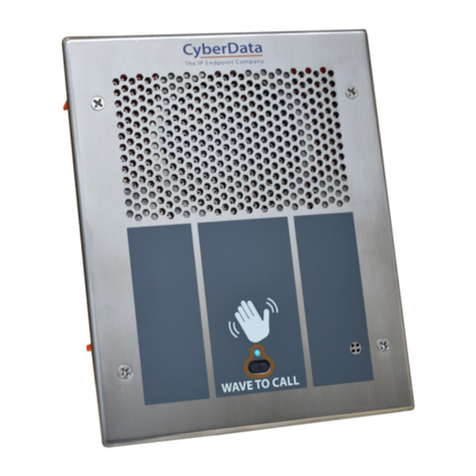
CyberData
CyberData 011530 Installation quick reference
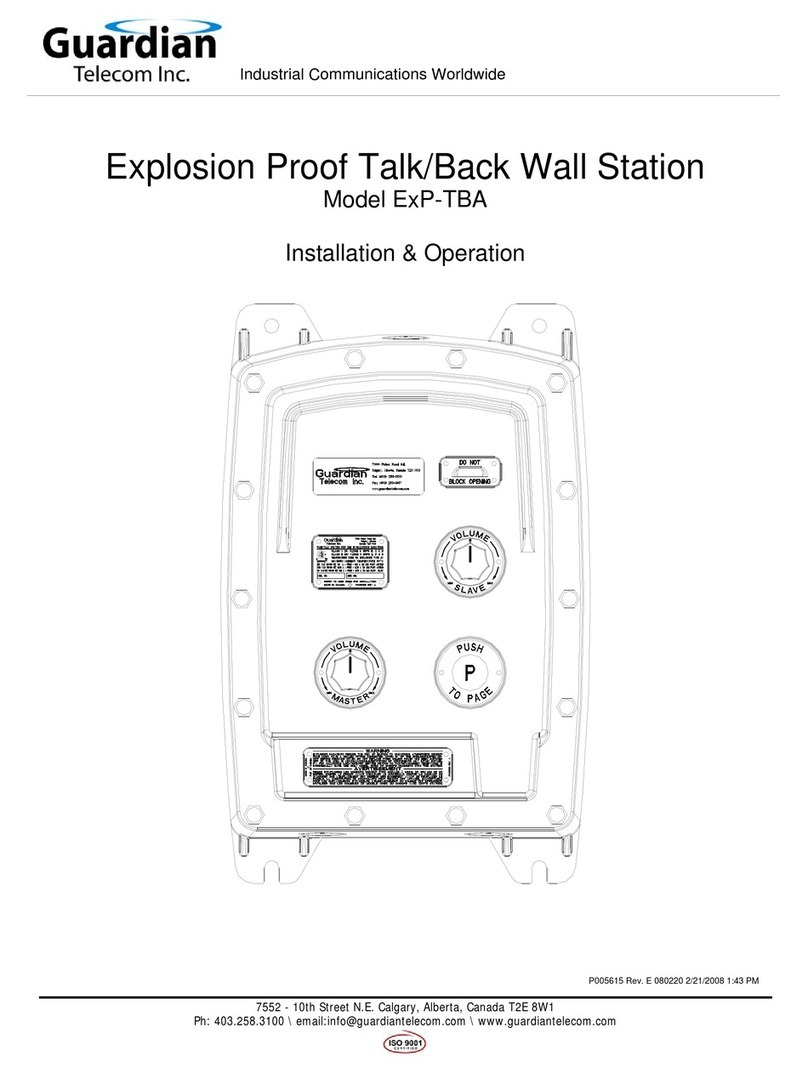
Guardian Telecom
Guardian Telecom ExP-TBA Installation & operation
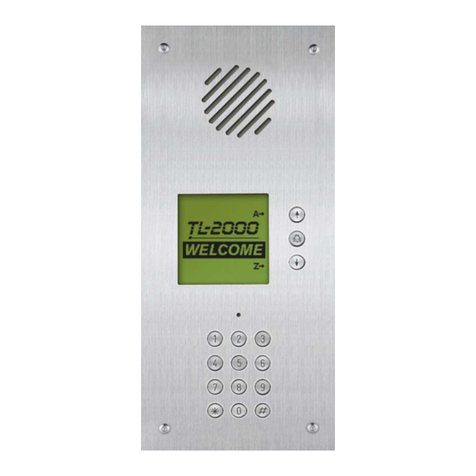
Aiphone
Aiphone TL-2000 Installation and operation manual
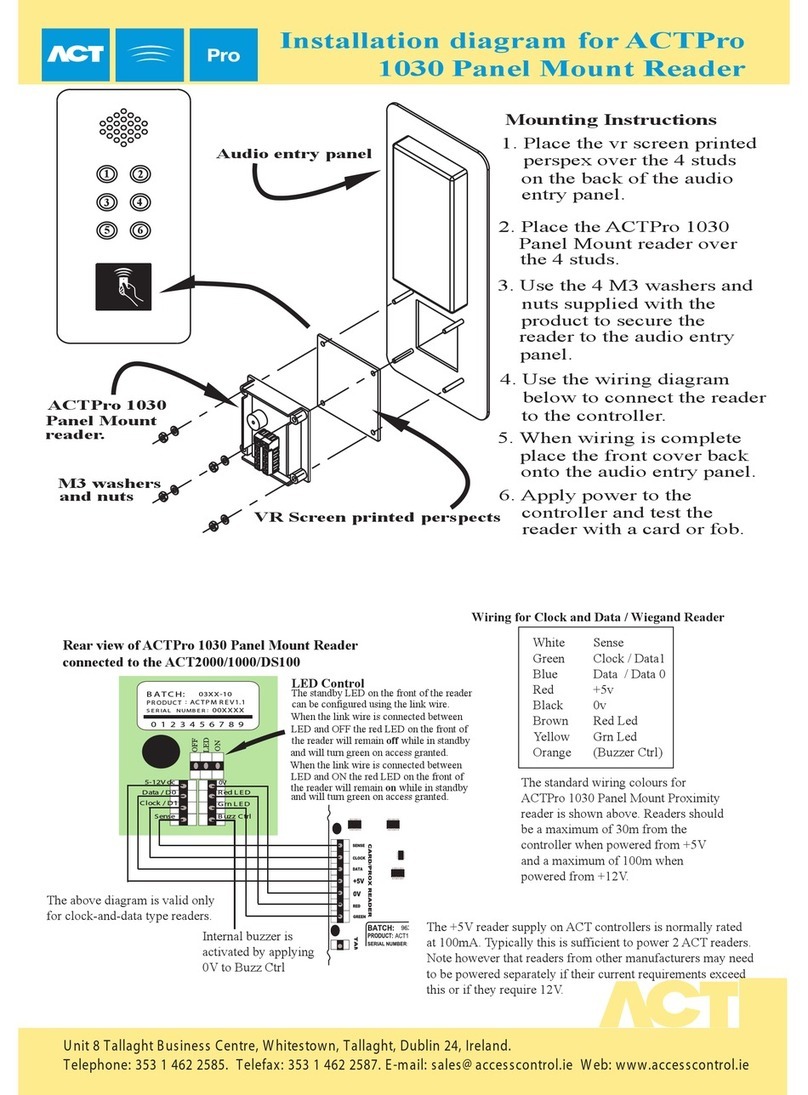
ACT
ACT ACTPRO 1030 PANEL MOUNT READER Installation
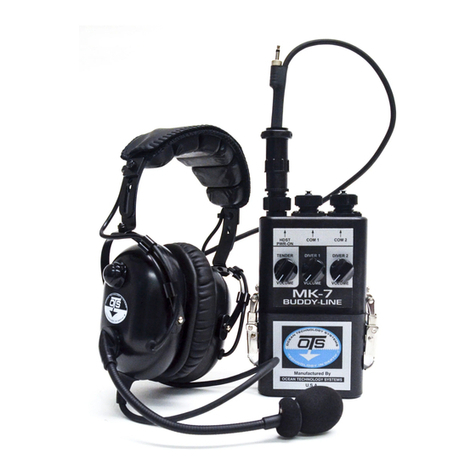
Ocean Technology Systems
Ocean Technology Systems MK-7 BUDDY-LINE user guide
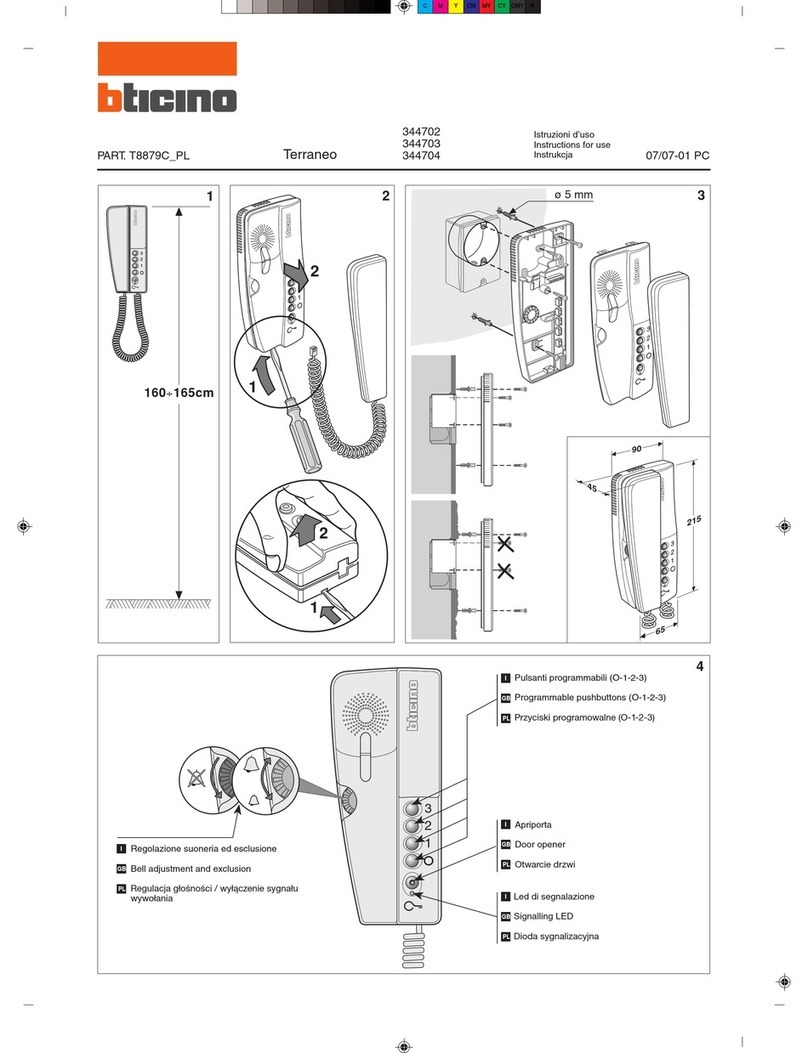
Bticino
Bticino terraneo Instructions for use
